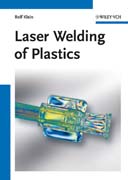
Laser welding of plastics: materials, processes and industrial applications
Klein, Rolf
This is the first detailed description in English of radiation and polymeric material interaction and the influences of thermal and optical material properties. As such, it provides comprehensive information on material and process characteristics as well as applications regarding plastic laser welding. The first part of this practical book introduces the structure and physical properties of plastics, before discussing the interaction of material and radiation inthe NIR and IR spectral range. This is followed by an overview of the physical foundations of laser radiation and laser sources used for plastic welding. The third part describes the main processes of laser welding thermoplastics, aswell as possibilities of process control, design of joint geometry, material compatibilities and adaptation of absorption of plastics to NIR radiation. Finally, the author explains applications of laser welding plastics using severalindustrial case studies from the automotive industry, household goods, and medical devices. Tailored to the needs of everyone dealing with laser welding ofplastics, especially engineers in packaging, component manufacturing, and themedical industry. ÍNDICE: Introduction 1 1 Material Properties of Plastics 3 1.1 Formation and Structure 3 1.2 Types of Plastics 7 1.2.1 Thermoplastic Resins 9 1.2.1.1 Amorphous Thermoplastics 10 1.2.1.2 Semicrystalline Thermoplastics 10 1.2.2 Elastomers 13 1.2.3 Thermosets 13 1.2.4 Polymer Compounds 14 1.2.4.1 Polymer Blends 14 1.2.4.2 Copolymers 15 1.2.4.3 Thermoplastic Elastomers 15 1.2.5 Polymer Composites 18 1.3 Thermal Properties 19 1.3.1 Phase Transitions 20 1.3.1.1 Glass Transition (Tg) 20 1.3.1.2 Flow Temperature (Tf) 20 1.3.1.3 Crystallite Melting Temperature (Tm) 20 1.3.1.4 Thermal Decomposition (Td) 21 1.3.2 Specific Volume 22 1.3.3 Heat Capacity 24 1.3.4 Heat Conduction 27 1.3.5 Temperature Conduction 30 1.3.5.1 Amorphous Thermoplastics 32 1.3.5.2 Semicrystalline Thermoplastics 33 1.4 Optical Properties 35 1.4.1 Optical Constants 36 1.4.2 Reflection, Transmission and Absorption Behavior 42 1.4.3 Scattering of NIR- and IR-Radiation in Plastics 46 1.4.4 Absorption of NIR-Laser Radiation (l ¼ 800 nm to 1200 nm) 49 1.4.4.1 Electronic Excitation 50 1.4.4.2 Vibronic Excitation 51 1.4.4.3 Summarizing Comment 52 1.4.5 Absorption of NIR-Laser Radiation (l ¼ 1200nm to 2500 nm) 54 1.4.6 Absorption of MIR-Laser Radiation (l ¼ 2.5 mm to 25 mm) 55 1.4.7 Adaptation of NIR-Radiation Absorption by Additives 59 1.4.7.1 Carbon Black 59 1.4.7.2 Inorganic Pigments 61 1.4.7.3 Organic Dyes 66 1.4.7.4 Summarizing Comment 66 References 66 2 Laser Sources for Plastic Welding 71 2.1 Properties of Laser Radiation 71 2.1.1 Laser Wavelength 73 2.1.2 Intensity Distribution 74 2.1.3 Beam Propagation 74 2.1.4 Focusing Properties 76 2.2 Types of Lasers 78 2.2.1 Diode Lasers (800 to 2000 nm) 78 2.2.2 Nd:YAG-Lasers (1064 nm) 80 2.2.3 Fiber Lasers 83 2.2.4 CO2-Lasers (10.6 mm) 85 2.2.5 Summary 87 2.3Beam Guiding and Focusing 88 2.3.1 Beam-Guiding Systems 88 2.3.1.1 Glass-Fiber Systems 88 2.3.1.2 Mirror Systems 93 2.3.2 Focusing Systems 95 2.3.2.1 Static Focusing Systems 95 2.3.2.2 Dynamic Focusing Systems 99 2.3.3 Beam-Shaping Optics 100 2.4 Principle Setup of Laser Welding Systems 101 References 107 3 Basics of Laser Plastic Welding 109 3.1 Heat Generation and Dissipation 109 3.1.1 Absorption of Laser Radiation 109 3.1.1.1 Direct Absorption 109 3.1.1.2 Indirect Absorption 110 3.1.1.3 Hindered Absorption by Internal Scattering 111 3.1.2 Transfer of Laser Energy into Process Heat 114 3.1.3 Dissipation of ProcessHeat 118 3.1.4 Process Simulation by Complex Computation 121 3.2 Theory of Fusion Process 126 3.2.1 Interdiffusion Process (Reptation Model) 127 3.2.2 Interchange of Macromolecules by Squeeze Flow Process 132 3.2.3 Mixing of Crystalline Phases 133 3.3 Material Compatibility 135 References 138 4 Process of Laser Plastic Welding 141 4.1 Basic Process Principles 141 4.1.1 Butt-Joint Welding 141 4.1.2 Through-Transmission Welding 143 4.2 Process Types 145 4.2.1 Contour Welding 145 4.2.2 Quasisimultaneous Welding 148 4.2.3 Simultaneous Welding 150 4.2.4 Special Processes 154 4.2.4.1 Mask
- ISBN: 978-3-527-40972-3
- Editorial: Wiley-VCH
- Encuadernacion: Cartoné
- Páginas: 260
- Fecha Publicación: 05/10/2011
- Nº Volúmenes: 1
- Idioma: Inglés
